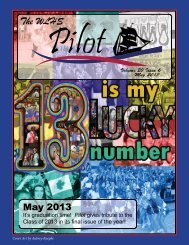Tim Thierfelder tim.thierfelder@wlhs.org 453-4567 x - Wisconsin ...
Tim Thierfelder tim.thierfelder@wlhs.org 453-4567 x - Wisconsin ...
Tim Thierfelder tim.thierfelder@wlhs.org 453-4567 x - Wisconsin ...
Create successful ePaper yourself
Turn your PDF publications into a flip-book with our unique Google optimized e-Paper software.
exponents. For example, we define 5 1/3 to be the cube root of 5 because we want (5 1/3 ) 3 = 5 (1/3)3 to hold,so (5 1/3 ) 3 must equal 5.N-RN.2. Rewrite expressions involving radicals and rational exponents using the properties of exponents.Unit Eight: Exponential & Logarithmic FunctionsF-BF.5. (+) Understand the inverse relationship between exponents and logarithms and use thisrelationship to solve problems involving logarithms and exponents.F-LE.2. Construct linear and exponential functions, including arithmetic and geometric sequences, givena graph, a description of a relationship, or two input-output pairs (include reading these from a table).F-LE.3. Observe using graphs and tables that a quantity increasing exponentially eventually exceeds aquantity increasing linearly, quadratically, or (more generally) as a polynomial function.F-LE.4. For exponential models, express as a logarithm the solution to ab ct = d where a, c, and d arenumbers and the base b is 2, 10, or e; evaluate the logarithm using technology.S-ID.6. Represent data on two quantitative variables on a scatter plot, and describe how the variables arerelated.ooa. Fit a function to the data; use functions fitted to data to solve problems in the context of the data. Usegiven functions or choose a function suggested by the context. Emphasize linear, quadratic, andexponential models.b. Informally assess the fit of a function by plotting and analyzing residuals.F-IF.8. Write a function defined by an expression in different but equivalent forms to reveal and explaindifferent properties of the function.ob. Use the properties of exponents to interpret expressions for exponential functions. For example,identify percent rate of change in functions such as y = (1.02)t, y = (0.97)t, y = (1.01)12t, y = (1.2)t/10, andclassify them as representing exponential growth or decay.Unit Nine: Rational Equations and FunctionsA-REI.2. Solve simple rational and radical equations in one variable, and give examples showing howextraneous solutions may arise.A-REI.11. Explain why the x-coordinates of the points where the graphs of the equations y = f(x) and y =g(x) intersect are the solutions of the equation f(x) = g(x); find the solutions approximately, e.g., usingtechnology to graph the functions, make tables of values, or find successive approximations. Includecases where f(x) and/or g(x) are linear, polynomial, rational, absolute value, exponential, and logarithmicfunctions. ★Unit Ten: Conic SectionsA-REI.7. Solve a simple system consisting of a linear equation and a quadratic equation in two variablesalgebraically and graphically. For example, find the points of intersection between the line y = –3x and thecircle x 2 + y 2 = 3.G-GPE.1. Derive the equation of a circle of given center and radius using the Pythagorean Theorem;complete the square to find the center and radius of a circle given by an equation.
















